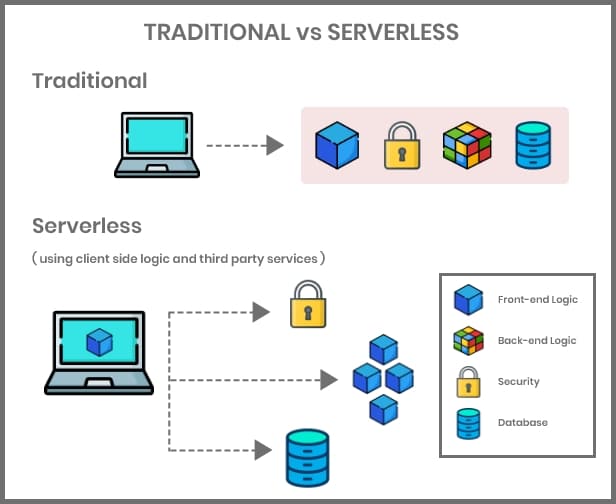
Navigating Cloud Migration: Overcoming Challenges and Maximizing Benefits
Exploring some of the key considerations and challenges in migrating legacy applications to the cloud and sharing practical strategies for a successful transition.
The FaaS market is expanding as a result of the rising popularity and demand for mobile solutions across multiple industries. FaaS is also helpful in creating Web apps, data/stream processing, online chatbots or backends for IoT devices. FaaS can assist you in managing and utilizing third-party services.
As applications become more usable and accessible, the need for serverless backend processing solutions becomes more acute. That’s where FaaS services come in handy.
In this article, we’ll explore some of the FaaS use cases, challenges and how different industries can benefit from this service.
Function-as-a-Service (FaaS), commonly referred to as serverless computing – a cloud-native development model that allows developers to build and run applications without having to manage servers. Using FaaS, you can break up your application into smaller “functions” that are activated by different events. The appropriate event source can then be associated with these functions, and they can be published to the vendor’s FaaS platform. It provides further advantages for software organizations in addition to eliminating the requirement for on-premises servers.
FaaS enables the creation of a “serverless” architecture primarily utilized for microservices development. Users can respond to events by executing code such as Javascript, Linux, or HTML without putting up the complex infrastructure often required for developing and running microservice applications.
When hosting a software application on the internet, a virtual or physical server, an operating system, and a web server must usually be set up and managed. However, with Function-as-a-Service, the cloud service provider automatically handles the physical hardware, operating system, and web server management, allowing developers to focus solely on specific functions in their application code.

FaaS provides an easy and efficient method for constructing cloud-based applications that are triggered or event-driven. It allows developers to create individual functions invoked as required and utilized by other programs, resulting in more modular software design. This approach can be applied to any cloud software project and is already being used in various application development and DevOps fields such as:
FaaS efficiently handles high-volume, parallel tasks because it enables fast separation and scaling of transactions. It can also be used for data processing, conversion, encoding, and aggregation. Using cloud provider servers with FaaS also offers benefits in terms of availability, security, and ease of maintenance, eliminating the need for manual management.
Additionally, FaaS simplifies the development process and makes it easy to provide updates to users. One of the critical benefits of FaaS is its ability to provide “on-demand” functionality, which allows for cost-effective infrastructure management by shutting down when not in use.

Function-as-a-Service is an excellent solution when seeking to move applications to the cloud in an efficient and cost-effective manner. Some of its key benefits include:
FaaS allows software developers to focus more on developing the code rather than managing the infrastructure. By breaking down the server into individual functions that can be scaled automatically and independently, there’s no need to worry about managing the underlying infrastructure, thus allowing more focus on the application’s code, which can significantly shorten the time-to-market.
With serverless FaaS providers, clients only pay for the computation time they use and do not have to pay for idle time, unlike traditional cloud providers. This eliminates the need for over-provisioning cloud resources and results in cost savings for the client.
FaaS can scale up or down as required, and functions are scaled automatically, independently, and instantly as needed. When demand drops, FaaS scales down accordingly.
Function-as-a-Service supports iterative development, getting applications up and running sooner, and allows for modifications to be made more easily.
FaaS providers can run applications closer to end-users, minimizing the need for requests to travel long distances to a central server, which can improve performance.
The cloud provider is responsible for the servers’ administration, availability, and scaling, allowing the developer to focus on the code. This can help businesses to reduce the operational costs and complexity associated with managing and scaling their infrastructure.
On the other side, there are also several challenges that organizations may face when using Function-as-a-Service. Here are some:
Regarding security, the vendor has control, and you may need more visibility to ensure that they follow the rules for using and storing certain data types.
When an outside party manages a portion of the infrastructure, it can be challenging to understand the system thoroughly, and troubleshooting becomes more complex.
Incorporating FaaS code into a local testing environment can be challenging, making thoroughly testing an application more difficult. This is because FaaS code is typically executed in a remote environment, such as in the cloud, and simulating this environment in a local setting can be difficult.
When building an application on a FaaS platform, there is a risk of becoming too reliant on a single vendor, which can make it difficult to switch to a different platform in the future because of the tight coupling of the application’s code with the FaaS platform’s API, functions, and resources. This can mean that significant re-architecting, re-coding, and testing would be required to migrate the application to another platform.
Function-as-a-Service is being adopted across various industries due to its cost-effectiveness, scalability, improved productivity and performance, faster time-to-market, better control of critical applications, and reduced business downtime and losses.
Here are some relevant examples:
Financial institutions are using FaaS for the automation of operations and cost saving. Additionally, FaaS can provide a comprehensive view of customers and financial products, helping with retention and acquisition. The ability to efficiently integrate multiple delivery channels for banks has also contributed to the growth of FaaS in the financial services industry.
The growing demand for efficient and secure FaaS systems in the media and digital content industry is driven by an increasing number of users and the adoption of related technologies. FaaS can help IT, and telecom companies meet the challenges of evolving customer requirements, such as changes in plans, devices, and payment models, and offer a hyper-personalized experience to customers at a lower cost, which can improve customer engagement and loyalty.
FaaS allows the retail industry to seamlessly integrate various shopping channels and offer a unique experience to connected consumers. Retailers are using FaaS to create a flexible, event-driven IT infrastructure that allows different applications to share and analyze information in real time, helping them to determine the best way to interact with customers and achieve agility.
The transportation and distribution industry faces several challenges, including industry regulations, security mandates, shipping delays, product errors, design faults, and outdated technology concerns. Cloud services from TSPs can assist with inventory tracking, logistics, and communication management, improving business and customer services.
Function-as-a-Service can greatly benefit software developers by eliminating the need to manage server infrastructure. It can be used for a wide range of applications, such as data streaming and processing, online applications, and chatbots.
FaaS is a valuable addition to a developer’s toolkit, and it is essential to consider how it can benefit your business. If your application is a good fit for the FaaS model, it can be an excellent platform for developing, deploying, and running production-grade applications. It is a cost-effective solution that offers scalability, flexibility, and a faster time-to-market for businesses of all sizes, including startups, SMEs, and large enterprises.

Exploring some of the key considerations and challenges in migrating legacy applications to the cloud and sharing practical strategies for a successful transition.

This article offers organizations a comprehensive guide to navigating the complexities of transitioning legacy applications to cloud infrastructure.

Delving into the essence of successfully implementing ML projects, exploring strategic approaches, the comprehensive life cycle from conception to deployment, and real-world industry applications.
Copyright © 2023 rinf.tech. All Rights Reserved.
Terms & Conditions. Cookie Policy. Privacy Policy.
Politica Avertizari de Integritate (RO)